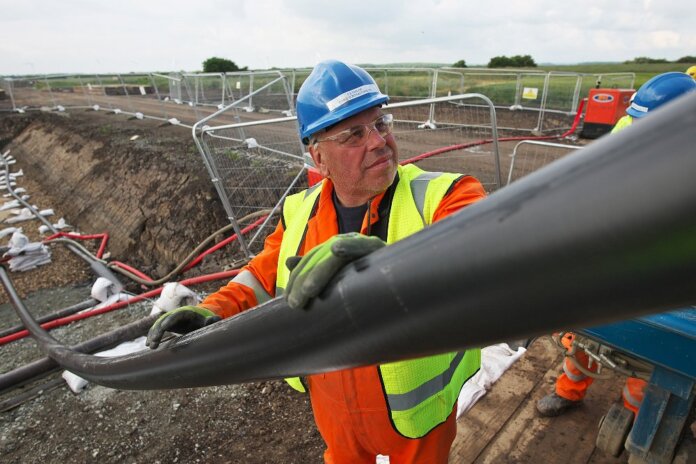The team building Dogger Bank Wind Farm has safely installed almost 73 miles of HVDC underground cables in East Riding of Yorkshire with support from Power Systems UK and cable installation specialists F B Taylor.
Onshore construction for the first two phases of Dogger Bank Wind Farm began in January 2020 when Jones Bros. Civil Engineering broke ground near the village of Ulrome in East Riding of Yorkshire.
Jones Bros commenced installation of the cable ducting system in spring 2020, with the support of Joseph Gallagher undertaking a series of horizontal directional drills in preparation for cable installation works to begin last summer.
This latest milestone marks the completion of HVDC cable installation work in East Riding, with the team now focusing on the installation of around four miles of HVAC cable from its convertor station site near Beverley, to the Creyke Beck electricity sub-station near Cottingham. Work is also underway to reinstate the land to its former condition, following completion of this part of the program.
“The whole team has worked incredibly hard and diligently since the start of 2020 to safely and efficiently prepare the 30-kilometer route, through a combination of trenching and drilling methods, before installing protective ducts and then feeding 3,362 tons of underground cables through these ducts,” says Oliver Flattery, onshore project manager for Dogger Bank Wind Farm.
“This has been a huge undertaking, and one we’re all proud to have been part of. We thank local residents and businesses in East Riding of Yorkshire for their patience and understanding over the last two years while this work has been taking place.”
Dogger Bank Wind Farm is being built in the North Sea more than 130 kilometer from the Yorkshire coast in three phases known as Dogger Bank A, B and C. Dogger Bank A and B phases will connect to the national grid near Beverley in East Riding of Yorkshire, while Dogger Bank C will connect to the grid near Redcar in the Tees Valley.
The renewable energy project, which will be capable of powering six million U.K. homes annually on completion, is a joint venture between SSE Renewables (40%), Equinor (40%) and Eni Plenitude (20%).
The electricity generated by the Dogger Bank A and B wind turbines will come ashore south of Bridlington at Ulrome in East Riding and be transmitted via underground HVDC cables to the onshore convertor station site in East Riding. The HVDC cable route ends at the convertor station site near Beverley, where two convertor stations are currently under construction. Here, the electricity will be converted from HVDC to HVAC current for transmission to homes and businesses via the UK grid network.
The Dogger Bank project is the first offshore wind farm in the UK to use HVDC technology, which allows electricity to be transmitted efficiently across long distances.
Offshore construction work on the first two phases of the project began in April with the start of work to install sub-sea HVDC cables off the Yorkshire coast. In July, the project celebrated the successful installation of the first foundation in the North Sea. Next year, the team will install the first turbine on Dogger Bank A, with a total 277 GE Renewable Energy Haliade-X turbines set to be installed on all three phases of the project by 2026.
Onshore work is also underway on the third phase of the windfarm in the Tees Valley, where the project is collaborating with neighboring Sofia Offshore Wind Farm, owned by RWE, to minimize disruption to the local community.




